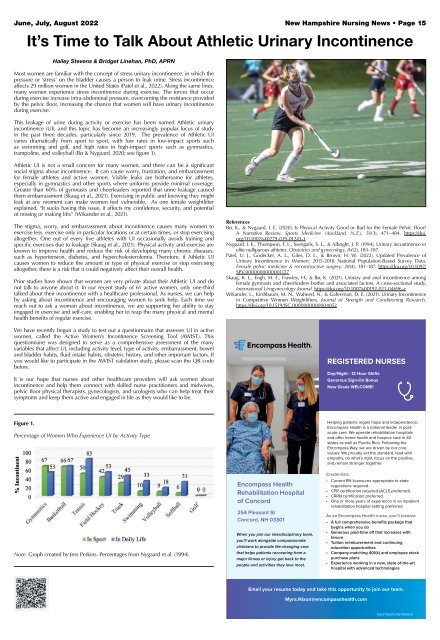New Hampshire Nursing News - June 2022
You also want an ePaper? Increase the reach of your titles
YUMPU automatically turns print PDFs into web optimized ePapers that Google loves.
<strong>June</strong>, July, August <strong>2022</strong> <strong>New</strong> <strong>Hampshire</strong> <strong>Nursing</strong> <strong>New</strong>s • Page 15<br />
It’s Time to Talk About Athletic Urinary Incontinence<br />
Hailey Stevens & Bridget Linehan, PhD, APRN<br />
Most women are familiar with the concept of stress urinary incontinence, in which the<br />
pressure or ‘stress’ on the bladder causes a person to leak urine. Stress incontinence<br />
affects 29 million women in the United States (Patel et al., <strong>2022</strong>). Along the same lines,<br />
many women experience stress incontinence during exercise. The forces that occur<br />
during exercise increase intra-abdominal pressure, overcoming the resistance provided<br />
by the pelvic floor, increasing the chance that women will have urinary incontinence<br />
during exercise.<br />
This leakage of urine during activity or exercise has been named Athletic urinary<br />
incontinence (UI), and this topic has become an increasingly popular focus of study<br />
in the past three decades, particularly since 2019. The prevalence of Athletic UI<br />
varies dramatically from sport to sport, with low rates in low-impact sports such<br />
as swimming and golf, and high rates in high-impact sports such as gymnastics,<br />
trampoline, and volleyball (Bø & Nygaard, 2020; see figure 1).<br />
Athletic UI is not a small concern for many women, and there can be a significant<br />
social stigma about incontinence. It can cause worry, frustration, and embarrassment<br />
for female athletes and active women. Visible leaks are bothersome for athletes,<br />
especially in gymnastics and other sports where uniforms provide minimal coverage.<br />
Greater than 60% of gymnasts and cheerleaders reported that urine leakage caused<br />
them embarrassment (Skaug et al., 2021). Exercising in public and knowing they might<br />
leak at any moment can make women feel vulnerable. As one female weightlifter<br />
explained, “It sucks having this issue, it affects my confidence, security, and potential<br />
of missing or making lifts” (Wikander et al., 2021).<br />
The stigma, worry, and embarrassment about incontinence causes many women to<br />
exercise less, exercise only in particular locations or at certain times, or stop exercising<br />
altogether. One out of every five athletes with UI occasionally avoids training and<br />
specific exercises due to leakage (Skaug et al., 2021). Physical activity and exercise are<br />
known to improve health and reduce the risk of developing many chronic diseases,<br />
such as hypertension, diabetes, and hypercholesterolemia. Therefore, if Athletic UI<br />
causes women to reduce the amount or type of physical exercise or stop exercising<br />
altogether, there is a risk that it could negatively affect their overall health.<br />
Prior studies have shown that women are very private about their Athletic UI and do<br />
not talk to anyone about it. In our recent study of 61 active women, only one-third<br />
talked about their incontinence with a healthcare professional. As nurses, we can help<br />
by asking about incontinence and encouraging women to seek help. Each time we<br />
reach out to ask a woman about incontinence, we are supporting her ability to stay<br />
engaged in exercise and self-care, enabling her to reap the many physical and mental<br />
health benefits of regular exercise.<br />
References<br />
Bø, K., & Nygaard, I. E. (2020). Is Physical Activity Good or Bad for the Female Pelvic Floor?<br />
A Narrative Review. Sports Medicine (Auckland, N.Z.), 50(3), 471–484. https://doi.<br />
org/10.1007/s40279-019-01243-1<br />
Nygaard, I. E., Thompson, F. L., Svengalis, S. L., & Albright, J. P. (1994). Urinary incontinence in<br />
elite nulliparous athletes. Obstetrics and gynecology, 84(2), 183–187.<br />
Patel, U. J., Godecker, A. L., Giles, D. L., & Brown, H. W. (<strong>2022</strong>). Updated Prevalence of<br />
Urinary Incontinence in Women: 2015-2018 National Population-Based Survey Data.<br />
Female pelvic medicine & reconstructive surgery, 28(4), 181–187. https://doi.org/10.1097/<br />
SPV.0000000000001127<br />
Skaug, K. L., Engh, M. E., Frawley, H., & Bø, K. (2021). Urinary and anal incontinence among<br />
female gymnasts and cheerleaders-bother and associated factors. A cross-sectional study.<br />
International Urogynecology Journal. https://doi.org/10.1007/s00192-021-04696-z<br />
Wikander, L., Kirshbaum, M. N., Waheed, N., & Gahreman, D. E. (2021). Urinary Incontinence<br />
in Competitive Women Weightlifters. Journal of Strength and Conditioning Research.<br />
https://doi.org/10.1519/JSC.0000000000004052<br />
We have recently begun a study to test out a questionnaire that assesses UI in active<br />
women, called the Active Women’s Incontinence Screening Tool (AWIST). This<br />
questionnaire was designed to serve as a comprehensive assessment of the many<br />
variables that affect UI, including activity level, type of activity, embarrassment, bowel<br />
and bladder habits, fluid intake habits, obstetric history, and other important factors. If<br />
you would like to participate in the AWIST validation study, please scan the QR code<br />
below.<br />
It is our hope that nurses and other healthcare providers will ask women about<br />
incontinence and help them connect with skilled nurse practitioners and midwives,<br />
pelvic floor physical therapists, gynecologists, and urologists who can help treat their<br />
symptoms and keep them active and engaged in life as they would like to be.<br />
Figure 1.<br />
Percentage of Women Who Experience UI by Activity Type<br />
Note. Graph created by Jess Perkins. Percentages from Nygaard et al. (1994).

















